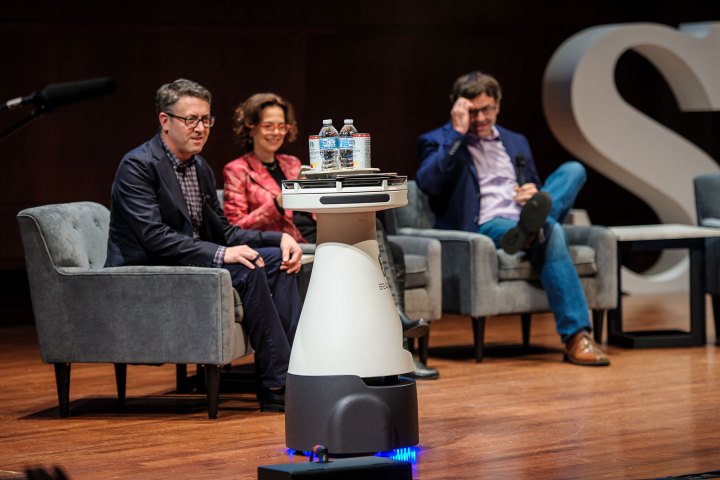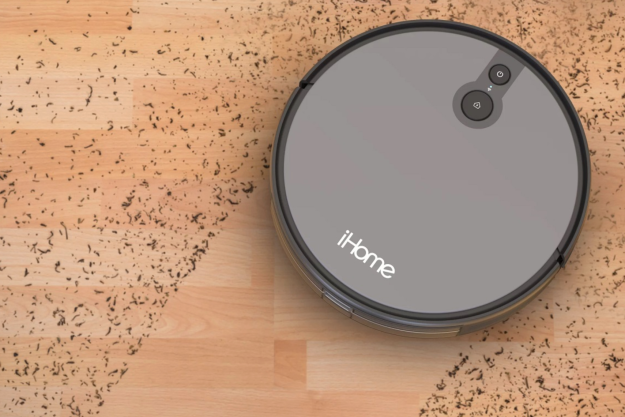
We’ve all gotten used to robots that can clean floors and automate manufacturing. But can they take over the often tricky work of preparing, serving and delivering food?
The answer, from a gaggle of entrepreneurs at the inaugural Articulate Food Robotics Summit in San Francisco earlier this week, was a resounding yes. Robots that can bus tables, toss salads, and bake bread (among other tasks) took center stage at the event, and their creators and the venture capitalists who back them believe they can revolutionize a wide range of food-related businesses. It was the first time that robotics startups mingled with large food chains and other industry players to discuss how robotics can make a difference in everything food-service related, said Michael Wolf, founder of The Spoon food tech blog and the Articulate event.

The most visible robots, to consumers, are likely to be those involving food prep and delivery. For example, Briggo’s robot baristas prepare coffee drinks on demand, typically in corporate environments: They are in use at Dell. You order and customize a drink using Briggo’s smartphone app, then collect it in person.
A Briggo Coffee Haus can prepare about 100 drinks an hour and serve 10 customers at a time, company founder and chief technical officer Chas Studor told the conference. But coffee addicts beware: The device can collect a lot of data about users’ coffee habits. (Coffee lovers can enjoy similar robot barista service at the BBox Cafe in Berkeley, California.)
Sally the salad maker
Also on display at the event: Sally the Robot, a vending machine that dispenses freshly tossed salads on demand. Created by Redwood City, California-based Chowbotics, Sally is already deployed in some 50 locations around the country.
It (she?) features a handsome touchscreen display on which you can either choose a standard salad or create your own from ingredients stored in the refrigerated unit. You can then watch Sally dispense the fixings, toss them with dressing (which you can also customize), and deliver it all to a cardboard bowl, much the way vending machines typically deliver hot beverages.

Food delivery is another area where robots are making inroads. Two companies at Articulate demonstrated very different approaches to delivering groceries and/or takeout orders. Kiwi designs tiny buggy-style electric robots that roll along city sidewalks at about 4 miles per hour and hold a couple of bags of groceries.
Kiwibots are a lot cheaper than drones, and are already fixtures at UC Berkeley, where company founders developed the technology. The customer collects the Kiwibot’s contents by running a smartphone app that successfully scans the QR code on the device.
AutoX, in contrast, is going with full-blown vehicles capable of freeway speeds and able to hold 20 to 30 grocery bags, allowing for multiple deliveries on a single run. Eventually, the company expects these delivery vehicles to be self-driving.
Restaurants may also take advantage of new technology to offload menial work. Redwood City, California-based Bear Robotics, for example, has created a robot named Penny that can serve and bus tables. “Everybody loved to see the robot in the restaurant,” Bear Robotics CEO John Ha said.
Asked whether human waiters resented their robotic co-worker, Ha said they appreciated not having to hoist the heaviest trays.
Asked whether human waiters resented their robotic co-worker, Ha said they appreciated not having to hoist the heaviest trays. They also found that tipping rates rose since the waiters had more time for customer service.
San Carlos, California-based Dishcraft Robotics, meanwhile, is working on back-of-house robots for food prep–robotic arms and the like. (We’ve seen other robot waiters, such as the Ginger created by Nepal’s Paaila Technology.)

Supermarkets are also looking into automation that goes beyond the self-checkout counters already installed in many stores. Albertson’s, for example, has partnered with Waltham, Massachusetts-based Takeoff Technologies to use robots in micro-fulfillment centers that handle online orders.
Following promising trials (including an ongoing one in Walla Walla, Washington), Coeur d’Alene, Idaho-based Wilkinson Baking Company is getting ready to deploy its Breadbot robotic bakers in three or the five top supermarket chains, CEO Randall Wilkinson said.
A large contraption somewhat reminiscent of a Rube Goldberg creation, a Breadbot can produce six loaves of bread an hour, or about 90 a day, using ingredients loaded the night before, Wilksinson said. Customers can pick up a loaf of freshly baked bread and use another machine to slice it to order (thin, medium or thick).

Wilkinson says Breadbots have the potential to bring shoppers who might otherwise purchase all their groceries online back to brick-and-mortar stores to enjoy the scent of baking bread and the ability to customize their slices. “People like to interact with their food,” he said.
So…will we see these robots in restaurants and grocery stores soon? And will they eventually replace humans in the food industry? Not so fast, Wolf said. While robots are being more widely used in test cases, there’s not universal adoption yet. Restaurants might be interested in robotics for rote activities like slicing vegetables or working the fryer, but there will always be a need for humans in the industry.
“In 2019 we could probably be seeing these things scaling more widely,” Wolf told Digital Trends. “We’re certainly not in a place where restaurants can just remove humans. The consensus is we’re not there yet, nor do we want to be.”
Editors' Recommendations
- Why Amazon acquiring iRobot will make Roombas even better
- If someone can make a robot that can avoid wires, it’s iRobot. Here’s why.


